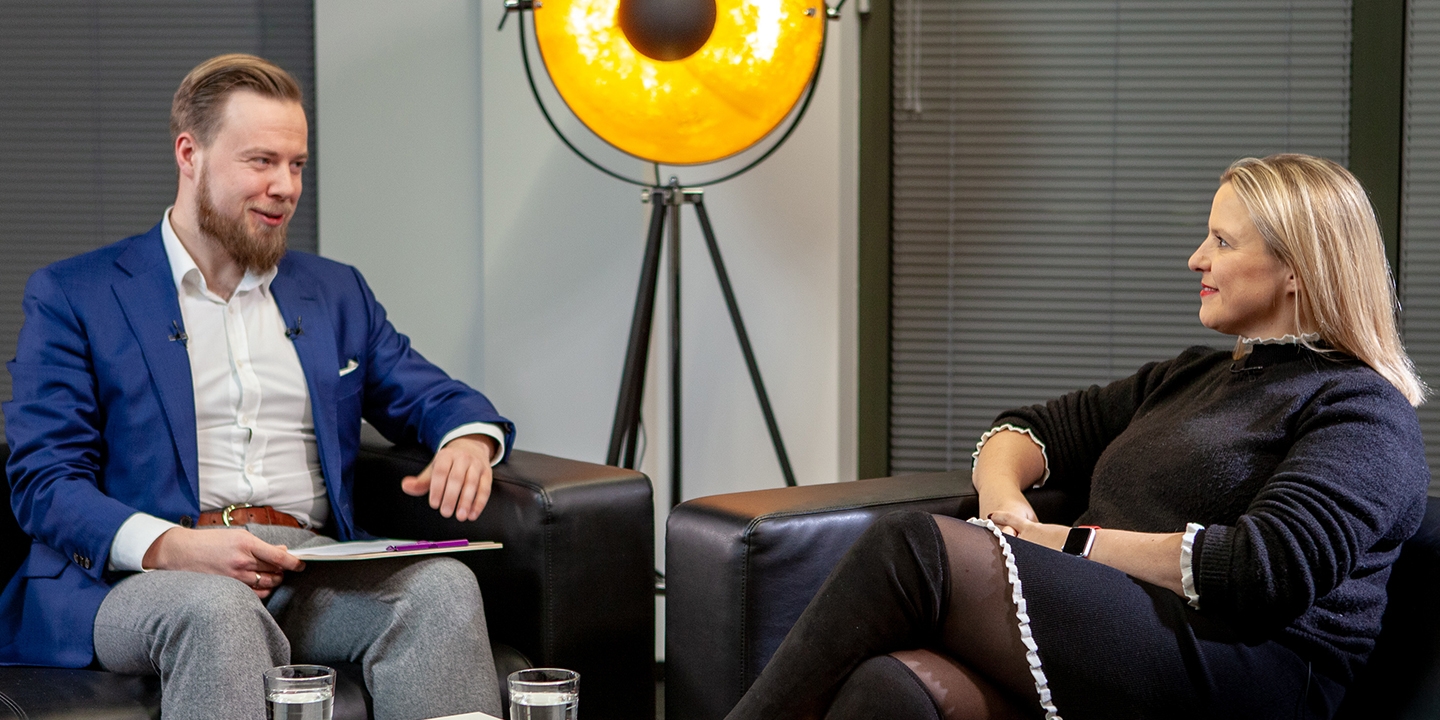- Insights hub
- /
- How Private Equity approa...

How Private Equity approaches IT in their investments with James Prebble
- DetailsAbout the talks
- TranscriptTranscript
How Private Equity approaches IT in their investments with James Prebble
Michał Grela
Relationship Manager at Future Processing
Delivering digital due diligence and digital transformation programmes backed by PE is a tough nut to crack. Let’s see how to tackle it!
One of the ways for a business to thrive and develop is to be backed by Private Equity. The areas which Private Equity targets are quite wide but very often it invests in the IT-related industries or directly into technologies developed by the companies from various sectors. Considering how well IT stands throughout the pandemics and how COVID accelerated the need for the digital transformation it seems that such a trend will only continue to gain grounds.
However, every owner should bear in mind that an investor usually has lots to say in terms of the technologies they invest in and quite often may impose certain solutions on the company. It is therefore essential to consider how the relation PE – owner could look like, on the one hand, from the point of view of an investor, and on the other hand, of an owner. It is crucial to understand that to make it all work and bring tangible benefits.
Today we will discuss with James Prebble how Private Equity approaches IT in their investments.
Michał Grela (MG): Hello, and welcome to yet another episode of IT Insights by Future Processing. Today the topic of the conversation is, how private equity approaches IT in their investments. One of the ways for a business to thrive and develop, is backed up by private equity. The areas which PE targets are quite wide, but very often it invests in the IT related industries, or directly into technologies developed by the companies from various sectors.
And especially now considering how well IT stands throughout the pandemics, and how COVID accelerated the need for the digital transformation, it seems that such a trend will only continue to gain grants. However, every owner of a company should bear in mind that an investor usually has a lot to say in terms of technologies they invest in. And quite often, may impose certain solutions on the company.
It is therefore essential to consider how the relation between the PE and the owner could look like, should look like on the one hand, from the point of view of an investor and on the other hand, of an owner. It’s crucial to understand to make it all work, how to make it all work and translate this relation into tangible benefits. And today, we’ll put a spotlight exactly on how to approach it right. My guest is James Prebble and yeah, James, if you could please introduce yourself. The stage is yours.
James Prebble (JP): Sure. Thanks Michael. So James Prebble here. I’m delighted to join you on this edition Michael. Yes, I am one of the co-founders of Palladium Digital group. We are a due diligence provider for the private equity community across Europe, advising them on their investments in respect of very technology oriented businesses. Looking at technology capabilities, digital capabilities for these businesses prior to investment. Specifically looking for both the existing capabilities within the business. The robustness of the technologies that are deployed and the subsequent opportunities that are available for investors, to either invest behind existing technologies, or introduce new technologies to these businesses, in order to make them ultimately more valuable, further down the line.
So that’s what my firm does. We look at that for, I should say, a number of firms from the huge enterprise deals that you might see in the top end of the market, all the way through to perhaps some of the smaller earlier stage companies, perhaps going through their first round of investment. So we’ve got a very broad perspective on the market, on the types of investments and have a lot of exposure to a lot of different technologies.
MG: Marvelous. I can wait to understand your insights and let’s jump into the first question straight away. But maybe first things first, can you describe from your perspective how the process of private equity investment usually looks like. Any sort of generalization we can make? How does usually …
JP: Sure. So I think obviously, depending on the nature of the investment, there’s a lot of different guises private equity investment can take. That could be injecting some growth capital into a business to help them accelerate and taking the small stake for that. It could be some minority stake investment. It could be majority stake investment and a takeover and ownership of the firm. And typically the work that I’m involved in, is on the latter side of that. So it’s the kind of the investment to take ownership of the farm and subsequently move it through to its next stage of growth. And then perhaps subsequent kind of further transaction.
How it works. I mean, the process for private equity firms looking for businesses to invest in, has always been quite a complex one. With so much competition in the market, with the market being as buoyant as it is. Actually finding good quality technology or IT oriented businesses to invest in, it’s actually becoming increasingly challenging.
So the first challenge for any private equity firm, is obviously sourcing opportunities to invest in. There are lots of partners that bring them opportunities and they have their own teams that also find opportunities. So I guess one of the first things that I always recommend to businesses who are seeking that private equity investment, is to make sure they are visible in the right circles, so that they can be spotted by private equity investors earlier, rather than than later.
But then the next stage of that of course, is for and the work that I’m heavily involved is, is understanding specifically what is the product investor might be buying. So am I buying a piece of proprietary technology? Am I buying something that’s unique? Am I buying a very technology oriented business, or data led business that’s perhaps using off the shelf solutions, to do something different? But what specifically am I getting here, or am I potential investor in?
And so we take it up to that part of the process. Post-transaction, we might work with them to help build the roadmap for the future of these businesses, but that’s typically our involvement in the private equity transaction.
MG: Thanks. That’s sounds fairly understandable. And how do you usually people prepare for such an event of such investment especially considering the owner’s point of view? What are the usual preparations steps?
JP: So I think preparation for an investment event, it does take time. And should be thought of many, many months in advance. 12 possibly more. And I think for the most part, most businesses are thinking about an exit event. I mean, the best businesses are thinking about their exit event the day that they start. They understand where they’re trying to get to and when they get there, they understand the value of what they’ve done and what they believe their returns should be.
So preparation almost starts on day one in some respects. But if we’re talking about rural preparation, if we’re talking about the kind of that period that leads up to the invitation to investors, to I guess, lift up the hood of your business and try and understand what’s underneath, then that preparation starts by, I think the first thing to do. And the most successful programs that I’ve worked across, are the ones where the business itself has got a very good, strong core team in place, that’s going to take responsibility for managing the requests of the investors.
So firstly being prepared, making sure you’ve got a good sales side advisor advising you on the process, or having a very good internal leadership team who know their responsibilities and what they’re going to have to do, the questions they’re going to have to answer. Now, if we’re going to talk specifically about technology today, or kind of the underlying of IT operating model within a business as well, but let’s talk about that broad chat of digital technology in IT.
The number one thing that a business can do to prepare itself, is documentation. Documentation on processes, documentation on decisions that were made, documentation on the technology that they have, how it’s maintained, how it is supported, previous history in terms of development, roadmap improvements, history in terms of outages, history in terms of how it’s supported. One of the things that that comes up time and time again, is an investor, a business we’ll see from investor, a big long information request list.
And in that information request list, will be a request for documentation that covers all of those things that I’ve just covered off. So the number one thing to do, is to make sure your documentation is in order. To make sure that you’ve got everything you need in terms of the investments that you’ve made, how technology is supported, how technology decisions were made, what the future roadmap looks like, the IT organization, all of the supporting processes, all of your data security. Everything that you would expect to see within the IT organization, make sure that documentation is ready, up-to-date and ready to go into the data room.
MG: All right. So the first and foremost documentation. But I guess there’s different point of views and what one would consider an opportunity for other, is a risk. And the next question I’d like to ask, is what are the differences and when it comes to what private equity considers a risk and what an opportunity? And what’s an acceptable risk of investment for a PE to go for?
JP: Michael, that was fantastic question. It’s a really, really good question. Because depending on the investment stage, there’s a different risk profile. If it’s perhaps an early stage investment, then absolutely, I think the investor is prepared to take more risk than they would if it was a bigger check size and a more mature business. Obviously, you want to take a little bit less risk there because of the exposure that you have in terms of the capital. That said, let’s start with the opportunities.
So what are they buying? And it’s the same irrespective for whether it’s a technology led business, IT led business, or whether it’s a service business or a manufacturing business. Everybody, you, me, investors, we’re buying a story, we’re buying the future. We’re not buying today, that’s what we’re looking at. We want to see what went on in the past and where we’ve got to today. That’s fine, but that’s history. What we’re really interested in, is something that I think business owners need to get their heads into if they’re thinking about again, taking on investment is, what’s the future equity story?
So we’re here today, but where are we going in the future? What’s the evolution of our technology? How are we building deeper moats in the market, so that people can’t replicate what we do? How do we drive home a competitive advantage through the way that we do things? Or why is what we have, so unique? And how many markets can I take it to and how much more headroom is there to go for? And I think so if you talk about opportunities, the investor is buying the opportunity. They’re buying what the future holds.
Now, I think that takes on different guises, personally. So in the early stage, and that leads us very nicely onto the risk side of things. If I’m working with a business that’s sitting within a good market, a growth market, and perhaps let’s say it’s an insurance business, right? Let’s say it’s an insurance business or something. And it’s sitting in a growth area. Maybe it’s the gig economy ensuring individuals like that. And there’s lots of headroom for growth. So the investor is very excited.
But let’s say this business is early stage and it has poor IT architecture, or underlying infrastructure. Let’s say it doesn’t have the right CRM in place, it doesn’t have the right insurance platform sitting underneath it. There’s a lot of manual process. If it’s an early stage business, in some respects, that’s nothing but opportunity. Because what it’s done, is it’s sitting in a market where it’s positioned itself well, and there’s lots of opportunity for growth, which excites the investors, excites the owners of the business.
But the fixes because of the size and stage of the business so relatively straightforward, the investment requirement to re-platform, or restructure the way the IT organization works, isn’t insurmountable. It can be achieved over a period of time and actually by implementing the fixes, by putting the right systems, processes, architecture in place, building in the data security parameters that you need. You’ve built an asset that’s more valuable to the next stage of investor.
Where that risk becomes too much, let’s say your business is in a slightly more traditional space, or perhaps less hyper growth, more that you’ve established yourself. Maybe you are an education technology provider. Okay? So from an education technology perspective, let’s say that we’ve got an established couple of players in there. If one of the businesses been invested in has kind of a, perhaps a shaky architecture, if there’s lots of outages in terms of technology, the roadmaps not developing as we might expect, some spear is decision-making has gone on.
Someone has decided to build their own custom engine, instead of buying something that’s off the shelf and available. And I’m relying on a team of developers to support that, but there’s no rationale for having made that decision. Now you’re tipping the balance of risk the wrong way. In a market where you don’t have the hyper-growth reward, where you’ve got a strong competitive dynamic, and you’ve got a business with an architecture that needs re-engineering, or decision-making that perhaps wasn’t the best decision-making, now now you’re exposing yourself to risk. And so you have to ask yourself, is it worth it?
MG: Well, that’s very interesting. And I guess a lot of entrepreneurs and startup founders right now, can be encouraged by the fact that you so strongly mentioned that it’s the opportunity the PE is buying, not the actual existing, tangible assets. Is it a plus or not? I don’t know. Perhaps we will get back to this question just yet. The thing I want to move forward to, is the technology aspects of that investment. Do PE investors usually use advisers on technology before investing in a company? How does that usually look like?
JP: Yeah. So I think almost without exception, they do. They certainly surround themselves with knowledgeable individuals who can provide a perspective in the early stages. So of course, these stages are a process. There’s often a stage where the private equity investor is getting to know the business. Trying to understand a little bit more about them building a relationship. And at that point, we’re not in a formal kind of diligence process. So what you might have is an expert, who’s familiar with the space sitting alongside, reviewing and supporting the private equity investors.
But as you move into a more formalized process, you then find that the advisory partners, the diligence providers and supporters, they then come in to support the business. And their role really, is to act as a, I guess the way I would describe it, is to act as a translation house between the business themselves on what they do and translate that to the investor in terms of what that means and whether or not this has been developed sensibly, has got a sense of what kind of architecture, has got something that they can rely on in the future, not to go wrong, but also to have opportunities to scale and to improve.
So from the private equity investor perspective, they are trying to surround themselves with as much knowledge as possible, to make the right decision. And I think it really helps in the relationship, if you use partners or advisors so private equity side of things. It helps with the relationship, if the advisor or partner being used, understands the business model of the business being invested in.
So can demonstrate some form of expertise, can show that they understand how that works so that they are … Because they have a job to do as well. Not only to represent the private equity firm in there, and to make sure they make the right decision, but they also have a job to make sure they represent the business faithfully to the private equity investor.
MG: There’s a lot to digest, but it does sound reasonable. So let’s imagine that we’re a owner that’s preparing for the big day. And then it’s trying to somehow pump up the value of the company. So usually where’s the … I don’t expect you to share any silver bullets, or there’s no magic wands. Let’s leave that aside. But if there’s a hidden value, people usually tend to miss when repairing for PE investment. What would that be? What should people pay more attention to?
JP: I think that’s quite straightforward once we’re actually. The thing that I think gets missed the most by the owners of the business, is not selling the uniqueness of the technology that they have developed, or the way that they use technology to drive their business. So an awful lot of businesses will talk about being data driven, or technology led. They’re the biggest keywords in any investment management presentation they might send around. Okay?
MG: Isn’t that just buzzwords usually?
JP: Absolutely. It is buzzwords. So they’re in every deck, they’re in every deck you see, but it’s very rare that they actually have it. And so I think for the true technology kind of oriented businesses, for those really data led businesses, if they’re the ones we’re talking to right now, which I hope we are, they owe it to themselves to really demonstrate how they are data led. And how they have developed unique technologies, because that is what … they are the silver bullet. That’s where the value lies.
If they built something unique and difficult to replicate. So I’ve seen businesses, I’ll give you an example. I’ve seen a business that developed an incredibly unique, even though it was very focused on … They sold inventory, let’s say that. They sold holiday inventory. But they had developed a very, very unique fitting methodology, in terms of how they use data on occupancy rates and price point and propensity to travel and weather and time and dates. And they’ve ingested all of this into a bidding engine that managed all of their media, to try and drive customer acquisition.
Incredible piece of technology that they’d invested in over years and years, and years and years, that had real value because it gave them competitive advantage. So playing up that side of things. And it doesn’t just have to be that that drives a marketing or sales engine for example. We work with a business that intelligently distributed resource, based on predictive analytics and demand. Again, a fantastically unique piece of technology that they developed, that deserved to be amplified further. And actually was extremely difficult to replicate and drove competitive advantage for the business in the market. So if there’s one thing, is if you do, if you are technology led, data led, or you have a uniqueness in the way that you’ve structured your technology, then absolutely make the most of it. And more.
MG: That’s assuming that you have something actually illegal.
JP: Otherwise, you’re going to go for the same multiples as everybody else. You’re going to find it hard to kind of push that value up unless you really do have something that is unique.
MG: All right. So that the technology uniqueness can definitely be the factor that would set you apart. And how does that relate to people? Are people something, the talent pool in the company, whatever you call it. Is it something that the PE actually takes look at, or is it completely irrelevant?
JP: Now, you’ve struck on something perfect there. The people within the business, they are human capital. It is incredibly important to investors because there is no value in all of the talent and capability sitting outside of the organization. So working with third parties is fine. Offshore development teams, outsourced IT, outsourced agency support is great, but if all the capability lies outside the business, there’s no value to it.
So actually the drivers of the business, those that lead it forward, those that push the envelope, that strive the new ways to do things, better ways to do things, that drive the innovation within the business, they need to live inside the business. So yeah, absolutely they do. So in all diligence that I’m aware of, in the kind of management diligence, in commercial diligence, in IT diligence, in digital diligence, looking at the people within the organization, is a key component part of those work streams.
And understanding where there might be gaps in resource, gaps in competency, but also understanding where there’s key man risks, key woman risks. Making sure that those individuals are adequately compensated or rewarded, should there be an investment event so that they are there in the future, is really important to investors. So yeah, I would say that the individuals and those … Because they’re as almost as important as the technology itself.
MG: That’s good to hear honestly speaking. So last but not least, what are the most common pitfalls owners make, when preparing for the investment event? What should they usually avoid and are not?
JP: Okay. So I think that there’s a few things. I’m going to maybe reel off a few things. I think one of the things not to do, let’s go back to that information request list. I want to know this, I want to know that, where’s the document for this? Where’s the document for that? What your protocols around this? My advice is, be honest. Don’t say something that you don’t have. That’s a big pitfall when you say, “We’ve got that. We’re working on it.” That will give the team a little heart attack they run around trying to fix that sort of something you don’t have.
So when you don’t have something, that’s not a problem. That doesn’t count against you. If something’s missing, be honest, it’s missing. It’s probably an opportunity to fix. If you don’t have a process or you don’t have the data, or you don’t have the security protocol. That’s okay to say that you don’t have it. So pitfall number one, don’t say stuff things that you have, when you don’t have them.
MG: I would say it’s a very universal tip. Business-wise generally speaking.
JP: Absolutely. But when you’re in the diligence process, because as an owner, you want to get that deal over the line. You might say things that you don’t have and you regret. So that’s the first one. The second pitfall, is-
MG: Even though … Apologies for interrupting. Even though you’re actually setting the promise of something that you don’t actually have yet, still the tip is to be transparent on what is there and what’s not there yet.
JP: Quite right. Quite right. Yeah. The second one is, don’t put too tight a timeframe on the deal. Everybody has a time in why I want the event to be finished by this month. And they have their sales side advisor drive it. 1st of July, 1st of July. Don’t put unrealistic timeframes on the deal. One, your investors might shortcut their diligence. As a result, they may miss some of the value that you have in your business and not give you the valuation that you perhaps want.
Number two, you’re going to put unnecessary stress on you as a business and your team, to get everything ready and to be sitting on investor calls constantly, to try and get to the actual event. So give yourself generous timeframes. If you think you’ve given yourself enough time, always give yourself two more weeks run off just in case, because the time can really, really catch up with you in these processes.
People like my business, we’re going to want to have a technology demonstration. And there’d be other interested parties who also want a technology demonstration. And then we’ll have questions after that event and then we’ll want documentation. So you understand how it can spread. And then when you get really, really close to the end, there’s always more questions. So allow plenty of time.
And then I think the third one, is again, common pitfalls and it ties very nicely back to what we said at the start. Be ready for the event by being as prepared as possible. Make sure you’re working with the sales side advisor, or if you’re not choosing to work with a sales side advisor, make sure you are prepared for the questions you’re going to be asked, the documentation you’re going to be asked to produce, and that you’ve got your investment story ready, that everybody in the business shares the same vision and can articulate it in the same way. So you’ve got a consistent story and that you’re ready to tell the investors about what’s in store for the future.
MG: Thank you for that recipe. It really was eye opening to go for this whole process in a so structured way. And I’m sure that this episode will be a good due diligence checklist for owners preparing for the investment event. Thank you James. Great having you.
JP: Pleasure. Thanks Michael.
INSIGHTS
Check similar insights
Contact
Get in touch
Have any question about specific material?
Let us know!







